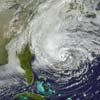How Climate Change Is Affecting Boating
By Charles Fort
We've all seen headlines such as "Last Year Hottest on Record," "Record Low Arctic Sea Ice," "Hurricane Patricia the Strongest Eastern Pacific Storm Ever Recorded." Here's what's happening.
First, there's a difference between "weather" and "climate." Weather is what's happening today and maybe the rest of the week. Climate refers to weather over long periods of time. While there may be some political disagreement over why changes have been occurring in the climate, nearly all climatologists and meteorologists agree on one fact: The wild weather is occurring because Earth is warming.
Warm air holds more moisture. Scientists at the National Ocean and Atmospheric Administration (NOAA) have accurate records going back to when modern record keeping began in 1880 showing the Earth's average surface temperature increasing by about 1.8 F since the early 20th century. Sounds like nothing. But it makes a major difference in the way our weather operates: About 6 degrees Fahrenheit is all that separates our current climate from an ice age.
As an example of current trends, 16 of the 17 warmest years in recorded history have occurred since 2000, and according to NASA, 2016 was the warmest ever recorded with 2017 coming in a close second. At the rate the climate is warming, NOAA forecasts a 3- to 7-degree increase by the end of this century.
When the planet warms even a degree or two, fundamental weather patterns change in counterintuitive ways, exacerbated by cyclical factors including El Niño and the oscillating jet stream. This creates more severe cold snaps and record snows in some areas. For instance, the spring of 2017 found California's drought-prone Sierra Nevada mountains at 200 percent of normal snowpack. On the other hand, last year Birmingham, Alabama, went a record-breaking 61 days without rain. During June a couple of years ago, temperatures in many parts of California, Arizona, and Nevada surged to record highs.
The Effects, Through Boaters' Eyes
The slow heating of the Earth creates visible changes, such as sea levels rising about 4 millimeters — roughly the thickness of four dimes — every year now. That doesn't sound like much. But residents of Miami can attest to how serious it is.
In the U.S., Miami is at one of the highest risks for rising water. Minor random "nuisance street flooding" (not from storm or tide) is becoming more common.
For boaters, over time, this means swampy areas begin to get covered, and rocks and sandbars that were visible become submerged. Couple that with potentially excessive silting due to runoff caused by heavier-than-normal rains and you begin to see how these changes affect boating.
Plus, sea level rise isn't only from rapidly melting ice caps. Water expands as it warms; about half the rise in sea level is due to thermal expansion of the water. As the Earth warms and more polar ice melts, that rate increases faster.
The Massive Gulf Stream Is Slowing
Anyone who has crossed in the Gulf Stream knows its power. Boaters may suddenly find themselves in a placid warm northbound "river" in the Atlantic Ocean, or they could be tossed about like a cork in a storm if even a moderate wind opposes the 3- to 5-knot current. But two recent independent studies concluded that the mighty Gulf Stream is slowing down — by about 15 percent. The reason seems to be to due, at least partly, to huge amounts of melting Arctic ice. That giant rush of freshwater on the surface reduces the density of the water and disrupts the sinking flow that drives the giant current. More melting will likely further slow the Gulf Stream.
Regardless of what's causing the slowdown, there are some concerns for boaters along the East Coast. The Gulf Stream is often thought of as a conveyor of heat, bringing warm equatorial water to colder arctic areas and vice versa. As in most things climate-related, it doesn't take much to upset our weather's equilibrium and, as the author of one of the studies said, "We should expect changes." A slower Gulf Stream is a warmer Gulf Stream, which may affect the size and intensity of Atlantic hurricanes and may cause sea levels to rise faster along the East Coast.
What Does This Mean For Boaters?
Hurricanes: Using supercomputers, NOAA scientists' most critical prediction, at least for boat owners, is that the warming of the planet creates hurricanes of more intensity. Brent Lofgren, climate research scientist for NOAA, explains that a hurricane's job is to move heat. More heat means more evaporated water in the atmosphere — a recipe for stronger storms. While we may not be able to accurately predict how many hurricanes each season will bring, there's general agreement that future hurricanes will be stronger.
A recent study by the respected World Meteorological Organization (WMO) shows that hurricane wind speed is likely to increase up to 11 percent, which translates to roughly a 60-percent increase in damage.
Storms and surge: Stronger hurricanes bring even more drenching rain. The WMO study forecasts slightly fewer but more intense hurricanes overall, and the National Weather Service Climate Prediction Center forecasts more Category 4 and 5 storms. People who live near the coast should prepare for stronger storms and higher surges.
Thunderstorms: Lofgren, who works in Michigan, says the Great Lakes area, which has one of the nation's largest concentrations of boaters, is facing changes. Increasing overall temperatures intensify the notorious thunderstorms that plague the lakes, he says; they may become more frequent and stronger.
Dry lakes: The warming climate, along with drawdowns for water users downstream who may need more water due to drier conditions, can cause lakes to experience more variable depths. Some large California lakes, already low from a decade of drought, were at record low levels in 2016 with marinas high and dry. With low snowpack from last winter, most southwestern lakes are still well below normal.
Heat waves: The U.S. Environmental Protection Agency says that an increase in average temperatures worldwide creates more frequent and intense heat waves. Lofgren agrees, explaining that a small increase in average temperatures has a strong impact on summer heat. For example, during a heat wave toward the end of spring 2016, Palm Springs California, hit a new record of 120 F. Heat waves also cause lake water to warm, which increases toxic algae blooms caused by agricultural runoff. In 2014, an algae bloom made it unsafe to swim in parts of western Lake Erie. Overall, Lofgren says increasing global temperatures tend to exacerbate local conditions: Dry places typically get less rain; wet places get more.
On the plus side, the National Hurricane Center is making strides in forecasting storms with better accuracy: The "cone of uncertainty" has decreased substantially over the past few years and last year was improved again by 6 percent; the wind forecast radius has been increased from 36 to 48 hours out; public advisories will now be made with information up to 72 hours out versus the previous 48 hours; and the agency will continue a new feature begun last year that forecasts storm surge watches and warnings.
Boaters spend an inordinate amount of time checking, talking about, cursing, or enjoying the weather. Our sport, and how we care for our boats, is dependent on it. Knowing what's ahead helps us better prepare.
— Published: October/November 2018
Recommended Articles
 How To Read Clouds
How To Read CloudsLearning what clouds can tell us is a useful skill that will help decide if it's safe to head on the water
 Anatomy Of A Nor'easter
Anatomy Of A Nor'easterNor'easters cause widespread damage, especially to boats. Prep for it with these simple precautions
 The Making Of A Superstorm
The Making Of A SuperstormWhat meteorological ingredients went into making Hurricane Sandy into a "superstorm"?
![]()
BoatUS Magazine Is A Benefit Of BoatUS Membership
Membership Also Provides:
- Subscription to the print version of BoatUS Magazine
- 4% back on purchases from West Marine stores or online at WestMarine.com
- Discounts on fuel, transient slips, repairs and more at over 1,000 businesses
- Deals on cruises, charters, car rentals, hotel stays and more ...
- All For Only $24 A Year!

